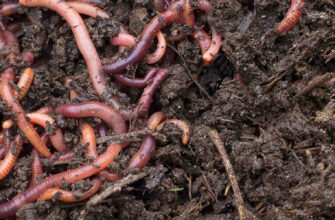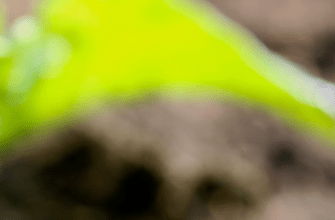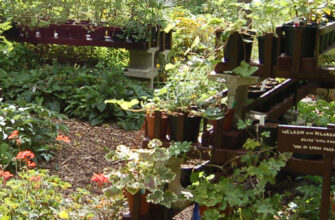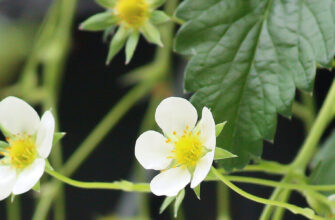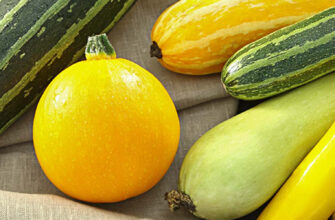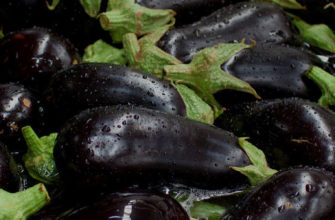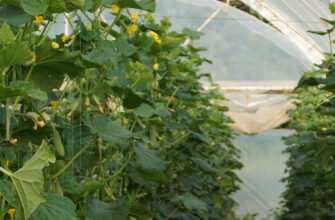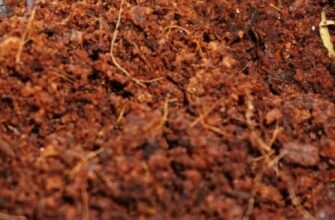The consumption of sweet peppers in Eastern Europe is increasing year by year. And it’s no coincidence, as peppers are among the champions in vitamin C content (on par with blackcurrants). That’s why pepper breeding is constantly evolving, and seed producers offer new and more promising hybrids every year. Therefore, we invite you to familiarize yourself with the complete technology of growing sweet peppers to achieve high yields.
- Biological Characteristics of Pepper
- Heat Requirements
- Light Requirements
- Soil and Air Humidity Requirements
- Soil and Nutrient Requirements
- Crop Rotation and Predecessors
- Soil Preparation
- Growing Pepper Seedlings: A Practical Guide
- Seedling Care
- Transplanting Pepper Seedlings
- Protecting Young Plants
- Fertilization and Nutrition of Pepper in Open Field Conditions
- Early-Stage Nutrition
- Fertilization Schedule
- Monitoring EC and Nutrient Uptake
- Soil pH and Nutrient Availability
- Pepper Irrigation
- Field Care for Peppers
- Harvesting and Storage of Peppers
- Did the pepper seedlings stop growing?
- What to Do If Pepper Seedlings Stop Growing?
Biological Characteristics of Pepper
Pepper, like other plants of the nightshade family, is a heat-loving crop. Its environmental requirements are similar to those of tomatoes, but peppers have their own unique biological traits.
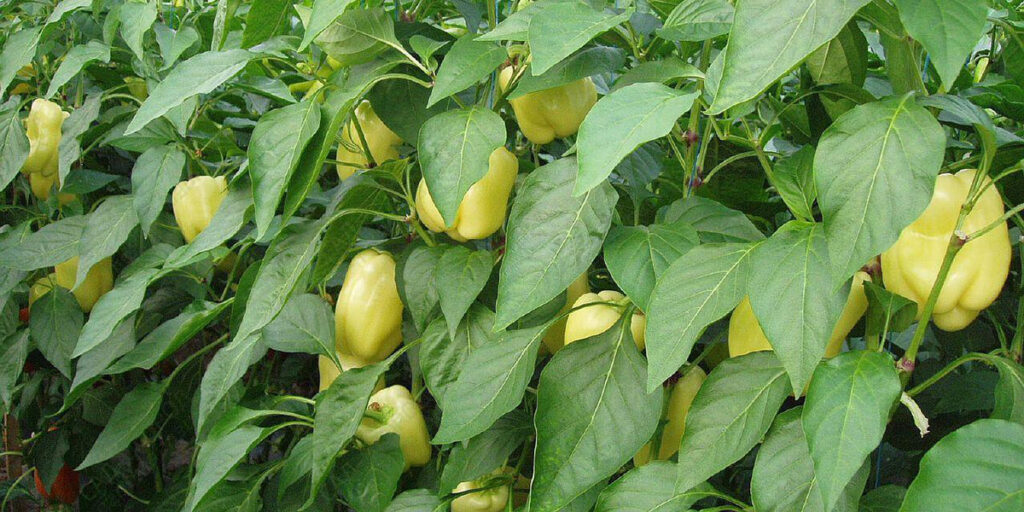
Heat Requirements
The optimal temperature for pepper growth and development is +20 to +30°C. However, seeds can germinate at temperatures as low as +13°C. High temperatures around +35°C negatively affect the plant, causing stress, flower and bud drop, and reduced fruit set. Peppers are also sensitive to low air temperatures; a lack of warmth can lead to bud shedding. Frosts down to +1°C are fatal to seedlings.
Light Requirements
Pepper is a light-loving plant. In low-light conditions, especially in winter greenhouses, it tends to shed buds and fruit sets. Leaves turn yellow and die off, stems become brittle and overall productivity decreases. In the shade, fruiting begins 10–12 days later and the fruits are smaller in size.
Soil and Air Humidity Requirements
Compared to tomatoes, pepper requires higher air humidity—about 70–80%. Under such conditions, the plant sets more fruit. Peppers also grow better in soil with higher moisture levels. However, excess water can disrupt soil temperature, restrict oxygen supply to the roots, lead to premature leaf drop and increase the risk of diseases.
Soil and Nutrient Requirements
What kind of soil does pepper prefer? It grows best in rich, loose soils with a pH level of 6.0–6.6. In heavy soils, growth slows down and the plant wilts.
Both nutrient deficiency and excess negatively impact pepper yield and quality. On poor soils, plants become stunted and grow slowly. Excess nitrogen promotes vegetative growth but delays fruit ripening. Too much phosphorus or potassium can slow down development, leading to lower yields.
Crop Rotation and Predecessors
The choice of preceding crop can significantly affect pepper yields. It is not recommended to plant pepper for 3–4 years on fields previously used for other nightshades (pepper, potato, tomato, eggplant), as they share common diseases and pests that may persist in the soil and reinfect the crop.
The best predecessors for pepper are onions, cruciferous vegetables (e.g., cabbage), melons, and cereal crops.
Soil Preparation
Proper soil preparation is crucial for successful pepper cultivation, as peppers do not tolerate compacted soils with poor oxygen supply. Preparation begins with shallow stubble cultivation (4–6 cm deep) after harvesting the previous crop. If the field is infested with perennial weeds, the depth should be increased to 10–12 cm. This is followed by plowing to a depth of 25–26 cm.
For fall fertilization, it is best to apply simple, easily soluble fertilizers. The application rates should be determined based on soil agrochemical analysis, which identifies macro- and micronutrient levels and helps calculate fertilizer needs per hectare based on the target yield.
According to the analysis results, 20% of nitrogen, 80% of phosphorus, and 50% of potassium from the total recommended amount are applied in autumn. The forms and types of fertilizers depend on the soil type and its acidity. Adequate calcium levels are also important, as calcium deficiency can cause blossom-end rot.
Organic fertilizers, such as compost or well-rotted manure (60–80 t/ha), should also be applied in autumn. Fertilizers are incorporated into the soil to a depth of 15–30 cm.
In spring, cultivation is done to a depth of 12–14 cm after pre-application of herbicides.
Growing Pepper Seedlings: A Practical Guide
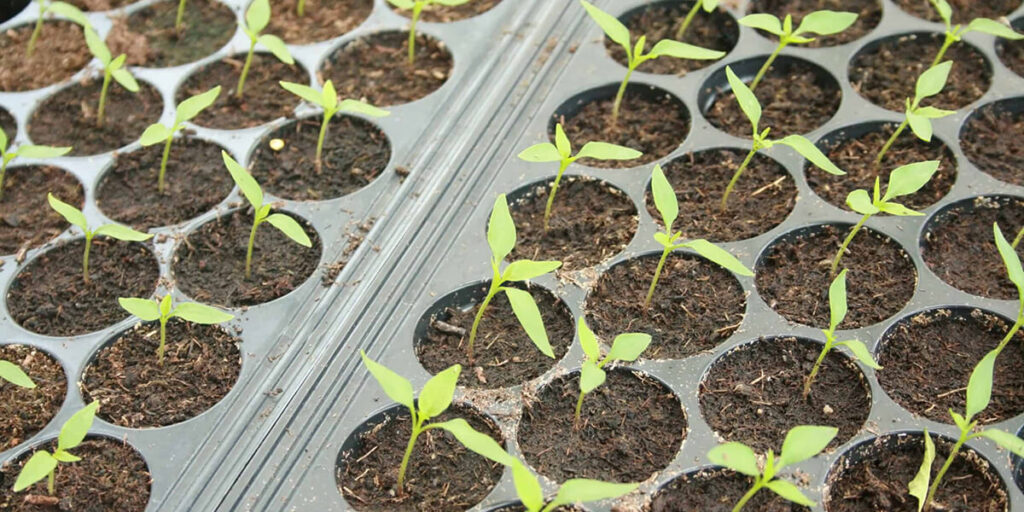
The easiest way to grow pepper seedlings is in seedling trays. For open-field cultivation, seeds are typically sown in trays between January and March, depending on the climate zone. It is important that by the time the seedlings are transplanted outdoors, the air temperature is consistently above +15°C and there is no risk of late frosts.
Seeds are sown in trays with 96 or 160 cells. The growing medium should be a clean peat-based substrate with a neutral pH. In the early stages, the sown trays should be regularly ventilated, with the air temperature maintained at +22 to +27°C and humidity at 80–90%. Under these conditions, pepper seedlings emerge within 12–15 days. After germination, the temperature should be lowered to +16 to +18°C during the day and +12 to +14°C at night.
Once the seedlings develop their first true leaves, they can be transplanted into individual pots (6×6 or 8×8 cm). After transplanting, water the seedlings thoroughly and provide shade if it is sunny outside. At this stage, pepper seedlings can tolerate low light better than tomatoes.
Seedling Care
Pepper seedlings require careful temperature control: +22 to +28°C on sunny days, +18 to +20°C on cloudy days, and +15 to +18°C at night. Watering should be regular—neither overwatering nor allowing the soil to dry out. Fertilizing with a balanced product such as “Kemira Lux” or other complete fertilizers is also recommended.
Seedlings are usually ready for transplanting into the open field at the age of 40–60 days. By this time, plants should have 5–6 true leaves and an average height of 15–16 cm.
Transplanting Pepper Seedlings
Seedlings are transplanted once temperatures are consistently warm. In temperate regions, this typically happens in May or early June. In fields with drip irrigation, pepper seedlings can be planted in single or double rows. The optimal planting density is 30,000–35,000 plants per hectare, or 40,000–50,000 when using later planting dates or overhead irrigation. Recommended spacing: 60–80–90 cm between rows and 35–40–50 cm between plants.
Before planting, lay out drip lines with emitters spaced 20–30 cm apart. To control weeds, retain soil moisture, and speed up soil warming, black plastic mulch is often placed over the drip lines. One day before planting, holes are made in the film according to the planting pattern, matching the size of the soil plug in the tray.
Important: Do not plant seedlings too deep. The top roots should remain level with the soil surface. If the stem is buried, it may swell due to excess moisture, leading to tissue cracking and potential infections. This can block the plant’s vascular system and cause wilting or death.
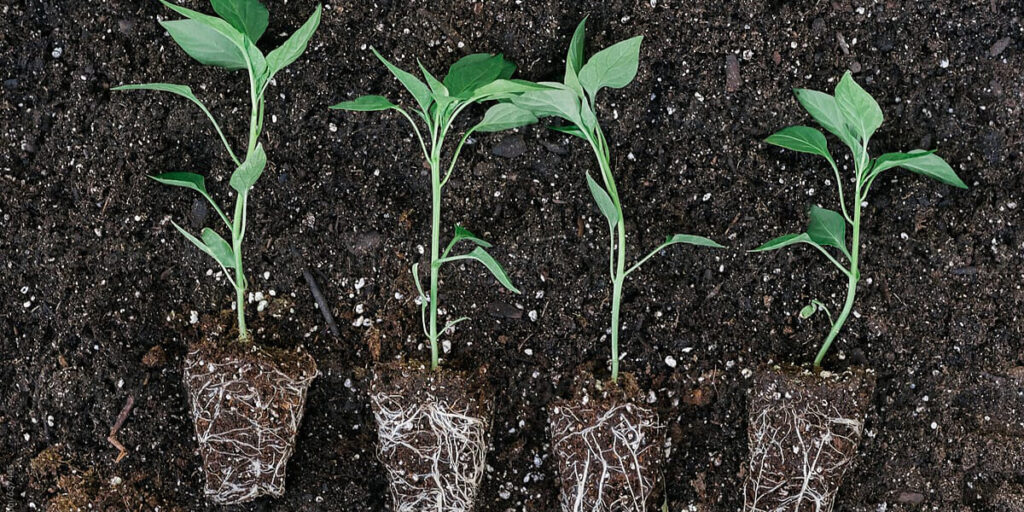
Protecting Young Plants
To achieve an earlier harvest, seedlings can be planted under low plastic tunnels. These mini-tunnels also protect young plants from strong winds and cold snaps. Install metal hoops in the field every 2 meters, and cover with plastic film or white agrofabric.
Before installing the hoops, it is advisable to stretch old drip tape over them to prevent friction and tearing of the cover material. The height of the tunnel should ensure that the cover does not touch the plants. Seedlings should be planted in moist soil, followed by thorough watering after transplanting.
Fertilization and Nutrition of Pepper in Open Field Conditions
To produce 1 ton of yield, pepper plants extract an average of 4.9 kg of nitrogen, 1.2 kg of phosphorus, and 5.6 kg of potassium from the soil. As previously mentioned, accurate fertilizer rates should be determined based on soil analysis.
Early-Stage Nutrition
To support proper root development in the early growth stage, it is advisable to apply a root growth stimulator. The EC (electrical conductivity) of the working solution should be maintained at 2.0–2.5 mS/cm.
Once the seedlings have established, fertigation (fertilization through irrigation) can begin. As fruits start forming, fertilizer application rates must increase to support development. Exact dosages depend on the hybrid, soil type, and climate.
Fertilization Schedule
- 7–10 days after transplanting – apply a phosphorus-rich fertilizer, such as NPK 13-40-13, to promote strong root and shoot development.
- During mass flowering – apply ammonium nitrate at a rate of 50–60 kg/ha to stimulate flowering.
- During fruit formation – apply potassium sulfate or a similar potassium fertilizer at 60–100 kg/ha to support fruit growth.
Monitoring EC and Nutrient Uptake
Measuring EC (electrical conductivity) in the root zone gives insights into nutrient uptake by the plants. Regular monitoring (twice a week, in multiple field locations) is recommended.
To perform an EC test:
- Collect a soil sample from the root zone at 15–20 cm depth.
- Mix 2/3 soil with 1/3 distilled water to create a 300 ml solution.
- Stir thoroughly and measure EC using a specialized meter.
Recommended EC levels:
- 0.35–0.45 mS/cm during active growth (lower end for sandy soils, higher for heavier soils),
- 0.4–0.5 mS/cm during fruit setting,
- 0.5–0.6 mS/cm during harvesting — this increase can be achieved by slightly reducing soil moisture.
Soil pH and Nutrient Availability
Another key factor in nutrient absorption is soil pH. The optimal range for pepper is 5.8–6.3.
- If the pH is too high, micronutrients become less available.
- If the pH is too low, macronutrients are less efficiently absorbed.
In many fields, soil pH is naturally high (7.5–8.3), so acidification may be needed. This can be done by adding nitric acid or orthophosphoric acid to the irrigation solution.
Important: Always add acid last, after fertilizers, to avoid a sudden pH drop. If the pH drops below 5.0, plant roots may suffer chemical burns.
Pepper Irrigation
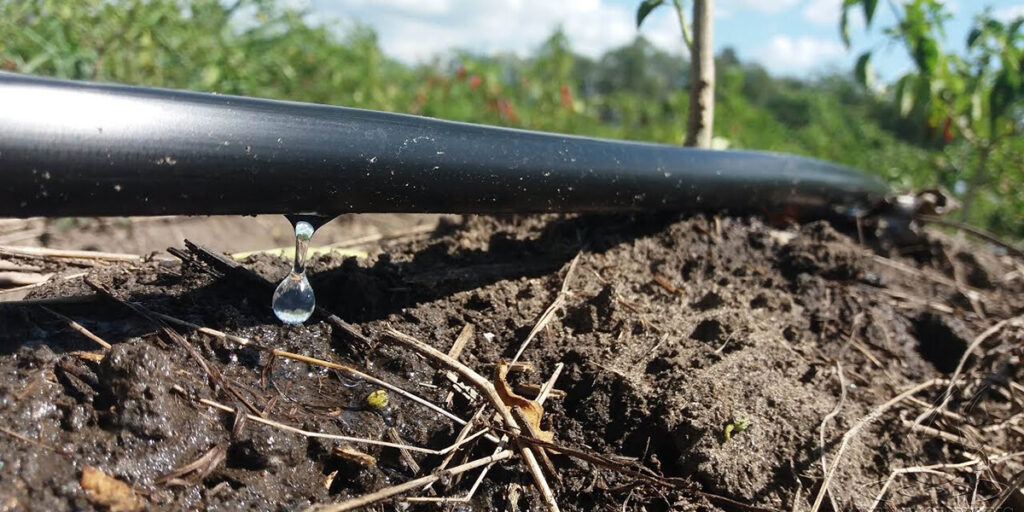
The most effective method for watering vegetables and fruit trees is drip irrigation.
One of the most common questions growers ask is: “How often should I water peppers?” As mentioned earlier, peppers require high humidity levels. Due to their relatively weak root systems, they are prone to stress, which can lead to flower drop, stunted growth, and halted development. This is why peppers need regular but controlled irrigation.
Drip irrigation is considered the best method, as it delivers water directly to the root zone. This minimizes water usage and reduces water contact with foliage, which helps prevent disease. Drip systems also allow for the application of fertilizers, growth stimulants, and pesticides—for example, for managing fusarium wilt or soil-dwelling pests.
With drip irrigation, soil moisture should be maintained at 75–80% during the first half of the growing season and about 70% during fruit development. The frequency and amount of watering will depend on the soil type, climatic conditions, and growing method.
Field Care for Peppers
During the growing season, it’s important to cultivate between rows periodically to control weeds and improve soil aeration.
Maintaining a pest-free environment is also essential. The most common pests affecting pepper plants include spider mites and cutworms. These and other pests can cause serious damage. For detailed information on pest identification and management, refer to: “Common Pepper Pests and How to Control Them.”
Peppers are also susceptible to diseases such as fusarium wilt, late blight, and viral infections. Viral diseases are especially difficult to treat, so prevention is key. Use resistant varieties and hybrids, and control insect vectors that transmit viruses. For more on this, see: “Diseases of Sweet and Hot Peppers – Identification and Treatment.”
Harvesting and Storage of Peppers
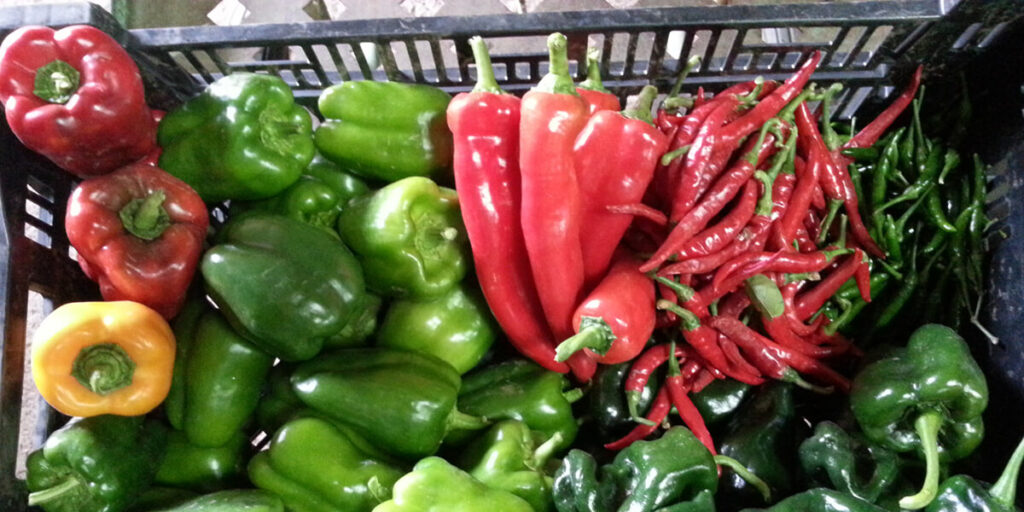
Sweet peppers can be harvested at both the technical maturity stage and biological ripeness.
- Technical maturity is when the fruit walls make a slight cracking sound when pressed.
- Biological ripeness occurs when peppers reach their full color, specific to the variety or hybrid.
Before storage, peppers should be sorted, and any soft, wilted, or diseased fruits should be discarded, as they will not store well and may infect healthy ones.
- Green (immature) peppers are best stored at +10 to +12°C.
- Fully ripe peppers should be stored at +7 to +9°C.
Maintaining high humidity in the storage area or refrigeration unit is also crucial for preserving fruit quality.
Did the pepper seedlings stop growing?
Stunted pepper seedlings can be a frustrating setback, but with the right care, you can get them back on track for a bountiful harvest! Sometimes, pepper seedlings halt their growth, showing signs like yellowing leaves, weak stems, or no new leaf development.
This usually indicates stress caused by improper conditions or care mistakes. Several factors can trigger this issue. Insufficient light, especially during short winter days, causes seedlings to stretch and weaken, as peppers are light-loving plants. Low temperatures below +15°C or sudden fluctuations slow development and may lead to bud drop. Overwatering or underwatering disrupts root nutrition, stunting growth. Nutrient deficiencies—particularly nitrogen, phosphorus, or potassium—or an imbalance (e.g., excess nitrogen) can also hinder progress. Soil pH outside the optimal range (6.0–6.6) limits nutrient uptake. Additionally, pests like aphids or diseases such as root rot can silently sabotage your seedlings. To revive stunted seedlings, act quickly to address the root cause.
What to Do If Pepper Seedlings Stop Growing?
- Provide ample light using grow lamps for 10–12 hours daily if natural light is lacking.
- Maintain stable temperatures: +22 to +28°C during the day and +15 to +18°C at night.
- Water consistently with warm water (+20–25°C), keeping the soil moist but not soggy.
- Test soil pH and adjust if needed—use dolomite flour to raise pH or sulfur to lower it.
- Apply a balanced fertilizer (e.g., NPK 10-10-10) suited for seedlings, following package instructions. Inspect plants for pests or disease symptoms and treat with appropriate insecticides or fungicides if necessary.
- Ensure good ventilation to prevent air stagnation.
With these steps, your pepper seedlings should resume healthy growth, ready for transplanting.
If you have found a spelling error, please, notify us by selecting that text and pressing Ctrl+Enter.

